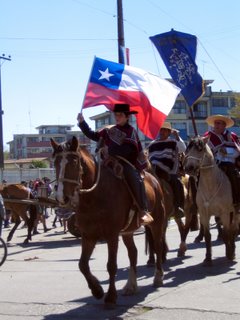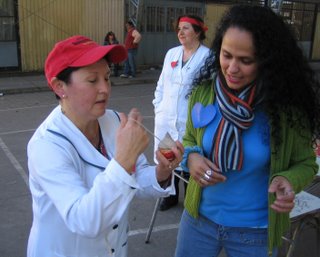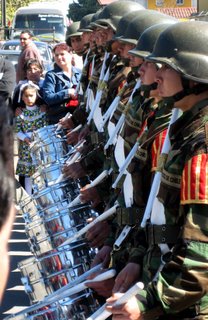 September brings the warmer winds of spring and one of the biggest national celebrations in Chile referred to as Fiestas Patrias or “el Dieciocho”. Though often thought of as Chile’s independence day, September 18 actually commemorates La primera junta nacional de Chile (Chilean leader’s proclamation of limited self-government) marking the beginning of their independence movement in 1810. Chile’s actual independence from Spain did not come until 1818. For the week leading up to September 18, the country celebrates its traditions and heritage with parades, festivals, foods, folk music, and dancing “la cueca”. The empanadas & asados (barbequed foods) seemed to be consumed at every meal and much like our 4th of July, excessive drinking (and I’m not talking about jugos) is common particularly among the men. That aside, it really is a treasured holiday event with the major focus on family and traditions.
September brings the warmer winds of spring and one of the biggest national celebrations in Chile referred to as Fiestas Patrias or “el Dieciocho”. Though often thought of as Chile’s independence day, September 18 actually commemorates La primera junta nacional de Chile (Chilean leader’s proclamation of limited self-government) marking the beginning of their independence movement in 1810. Chile’s actual independence from Spain did not come until 1818. For the week leading up to September 18, the country celebrates its traditions and heritage with parades, festivals, foods, folk music, and dancing “la cueca”. The empanadas & asados (barbequed foods) seemed to be consumed at every meal and much like our 4th of July, excessive drinking (and I’m not talking about jugos) is common particularly among the men. That aside, it really is a treasured holiday event with the major focus on family and traditions.“Abuela” our new friend who owns the house we are renting, brought some homemade wine, empanadas and desserts to initiate us into the holiday week. We were fortunate enough to attend several different Fiestas Patrias events over the week starting at the Liceo San Pedro (Sara Marisol’s high school).
 After only a couple of classes in the morning, the students and teachers gathered in the school’s outdoor basketball courtyard to begin the festivities: traditional food and dancing the “La Cueca” were the main events. La Cueca, the national dance of Chile, is characterized by flowing motions created with handkerchiefs by both partners while set to upbeat guitars rhythms. Style, flow, creativity, traditional costumes and synergy make for a good la cueca dance. La cueca dance competitions are held throughout the country particularly at this time of the year.
After only a couple of classes in the morning, the students and teachers gathered in the school’s outdoor basketball courtyard to begin the festivities: traditional food and dancing the “La Cueca” were the main events. La Cueca, the national dance of Chile, is characterized by flowing motions created with handkerchiefs by both partners while set to upbeat guitars rhythms. Style, flow, creativity, traditional costumes and synergy make for a good la cueca dance. La cueca dance competitions are held throughout the country particularly at this time of the year. Some sort of boche-type game, spinning tops, singing, trivia, along with chanting antagonizing rhymes at the other team while drinking Pisco sours were some of the more memorable activities. Here Sara Marisol gets a quick lesson from a fellow teacher on proper top winding technique. Asados including sausages, chicken and beef were cooked by several teachers in an open pit fire built in the courtyard. (Unfortunately for Sara Marisol, the Chileans definitely love their meats and seem to have some at every meal). After a nice formal lunch with the staff, the La Cueca dancing commenced and continued on into the evening hours.
Some sort of boche-type game, spinning tops, singing, trivia, along with chanting antagonizing rhymes at the other team while drinking Pisco sours were some of the more memorable activities. Here Sara Marisol gets a quick lesson from a fellow teacher on proper top winding technique. Asados including sausages, chicken and beef were cooked by several teachers in an open pit fire built in the courtyard. (Unfortunately for Sara Marisol, the Chileans definitely love their meats and seem to have some at every meal). After a nice formal lunch with the staff, the La Cueca dancing commenced and continued on into the evening hours. On the weekend, we attended a couple of Fiestas Patrias parades and festivals: one in our neighborhood and the other in a small rural town, Santa Juana, about an hour away. The parades in the small towns hold nothing back: every form of locomotion that the city owns is showcased in the affair including the sparkly-clean garbage truck and a shiny, new long-distance passenger bus (especially purchased from New Zealand).
On the weekend, we attended a couple of Fiestas Patrias parades and festivals: one in our neighborhood and the other in a small rural town, Santa Juana, about an hour away. The parades in the small towns hold nothing back: every form of locomotion that the city owns is showcased in the affair including the sparkly-clean garbage truck and a shiny, new long-distance passenger bus (especially purchased from New Zealand).  Nathan really enjoyed all the events and we must say that despite the lack of impressive fireworks, Fiestas Patrias made the “4th of July” holiday seem a little deficient at times.
Nathan really enjoyed all the events and we must say that despite the lack of impressive fireworks, Fiestas Patrias made the “4th of July” holiday seem a little deficient at times.